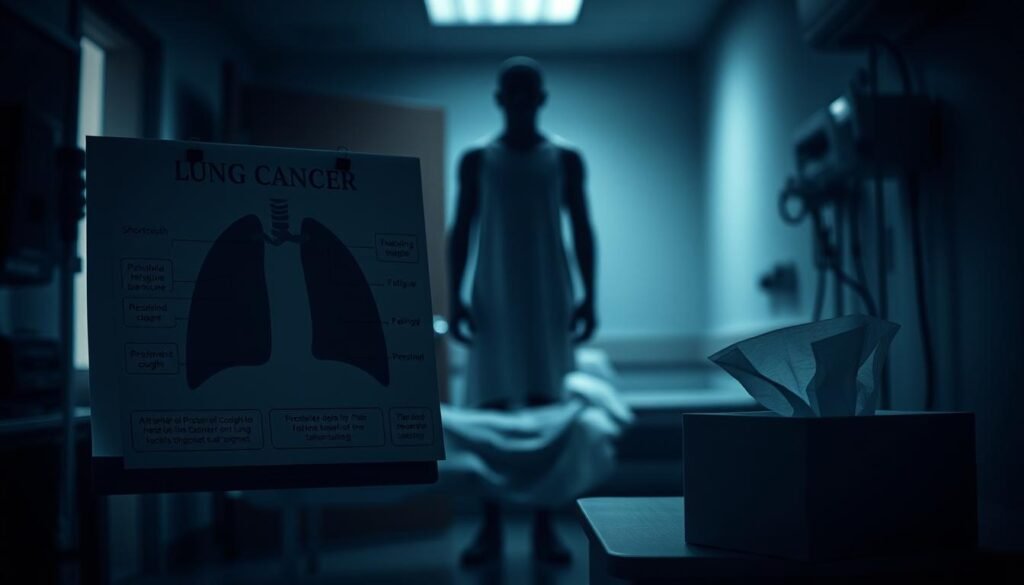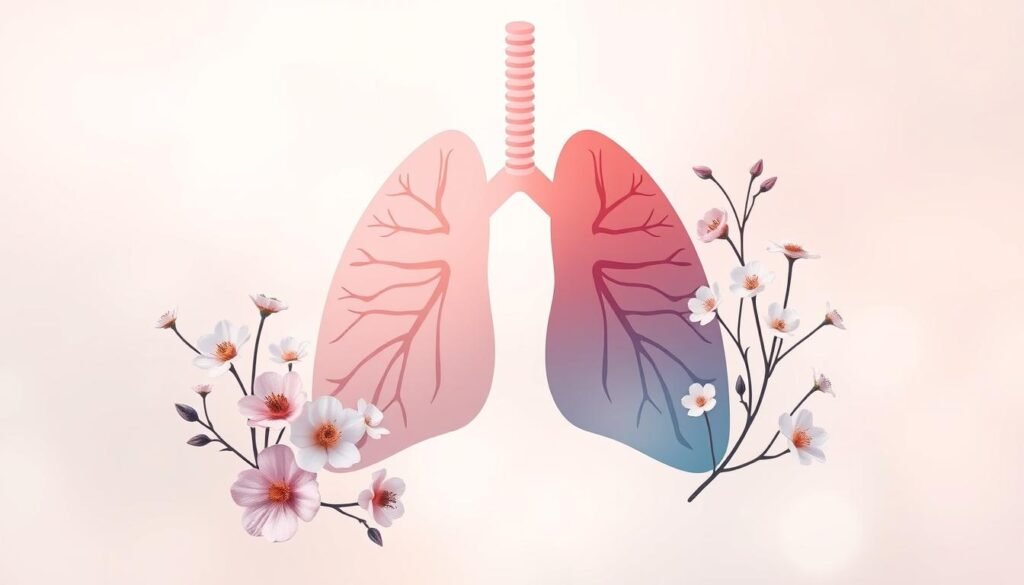Shockingly, only a few – less than 10% – who are diagnosed with stage 4 lung cancer live past five years. This fact highlights the critical need for more awareness and knowledge about lung cancer adenocarcinoma at stage 4. In this advanced stage, the cancer spreads far from where it started. This makes treatment harder and worsens the outlook for patients.
Talking about this diagnosis can be tough for patients and families. But, understanding what this disease is all about is key. This article will shed light on important things like symptoms, how it can be treated, and survival chances. It aims to provide useful information for anyone facing stage 4 adenocarcinoma.
Key Takeaways
- Stage 4 lung cancer adenocarcinoma has a five-year relative survival rate of only 9%.
- This stage typically indicates significant metastatic spread of the disease.
- Common lung cancer symptoms include persistent cough, chest pain, and unintentional weight loss.
- Treatment options may include chemotherapy, targeted therapy, and palliative care.
- Understanding the factors influencing prognosis can guide treatment decisions.
Understanding Lung Cancer Staging
Lung cancer staging is crucial for diagnosis and treatment. It uses the Tumor, Node, Metastasis (TNM) system. This system breaks lung cancer into four stages. Stage 4 means the cancer has spread beyond the lungs.
Stage 4 is split into 4A and 4B. Each shows how far the cancer has spread. This staging helps in making treatment plans and helps patients understand their condition better.
In stage 4, cancer has reached other organs. Treatment depends on cancer type, where it has spread, and patient health. Knowing these stages helps doctors create customized treatments for better results.
What is Stage 4 Lung Cancer?
Stage 4 lung cancer is also called metastatic lung cancer. It’s the last stage of this disease. By this time, cancer cells have spread from the lungs to other parts and organs. This stage is split into 4A and 4B categories. In 4A, the cancer might have reached places close by or just one organ far away. But in 4B, it’s found in several distant locations.
It’s crucial to understand advanced lung cancer to manage and treat it. Doctors use tests like CT scans and MRIs to see how far cancer has spread. If you have stage 4 lung cancer, you might notice coughing a lot, losing a lot of weight, and feeling very tired.
People with this diagnosis have several treatment options. Treatments like chemotherapy, targeted therapy, and immunotherapy aim to control cancer, not cure it. They try to slow cancer down and make life better. Supportive care is also important. For more details on treatments, check out this comprehensive overview.
Lung Cancer Adenocarcinoma Stage 4: Symptoms and Signs
Stage 4 lung cancer adenocarcinoma shows many lung cancer symptoms in its late phase. Patients often have a lasting cough and may cough up blood. They might feel chest pain and lose a lot of weight. These troubling symptoms may show the cancer has spread, leading to headaches, jaundice, and swollen lymph nodes.
It’s critical to spot these lung cancer adenocarcinoma symptoms early. Doing so can lead to better care and results. As cancer grows, symptoms majorly impact patients’ health. Getting medical advice early can help manage the disease sooner.
| Symptom | Description |
|---|---|
| Persistent Cough | A cough that continues for a long period and may worsen over time. |
| Hemoptysis | Coughing up blood, indicating potential tumor activity. |
| Chest Pain | Discomfort or pain in the chest region; may worsen with deep breaths or coughing. |
| Significant Weight Loss | A noticeable decrease in body weight, often due to the body’s response to cancer. |
| Headaches | Possible neurological symptoms from metastasis to the brain. |
| Jaundice | Yellowing of the skin and eyes, can signify liver involvement. |
| Swollen Lymph Nodes | Enlarged lymph nodes in the neck or chest area due to cancer spread. |
Consulting a healthcare provider is vital for anyone with these symptoms. Knowing the signs of stage 4 lung cancer can greatly help. It can make treatments more effective and improve life quality.
Common Symptoms of Stage 4 Lung Cancer
A persistent, worsening cough is often a sign of stage 4 lung cancer. Patients may also have trouble breathing and could get infections like bronchitis. These common symptoms of lung cancer greatly affect their daily lives.
Fatigue and losing weight without trying are also symptoms. People may feel extremely tired and eat much less. Breathing can get more difficult, and some might wheeze as the illness gets worse.
When stage 4 lung cancer spreads, it can cause bone pain and affect the brain. This might lead to headaches, seizures, and confusion. Knowing these stage 4 lung cancer symptoms helps in getting the right treatment quickly.
Dealing with these symptoms can improve patients’ life quality. For more details on lung cancer, check out this comprehensive guide.

Non-Small Cell Lung Cancer: Stage 4 Explained
Non-small cell lung cancer (NSCLC) is the most common type of lung cancer. About 40% of patients find out they have stage 4 NSCLC when they’re first diagnosed. This stage means the cancer has spread far from the lungs. This changes how doctors treat the cancer and the patient’s outlook.
Stage 4 NSCLC is split into two substages, called 4A and 4B. Cancer in 4A might have spread to nearby areas or lymph nodes. But in 4B, it has gone to other important organs. Knowing the right substage helps doctors choose the best treatment. The chance of living five years is about 4% and most patients live about eight months after finding out.
Two-thirds of people with NSCLC are diagnosed at this advanced stage. This shows we need better ways to find the disease early. Some patients have certain genetic changes, like the KRAS G12C mutation found in 13% of NSCLC cases. They might do well with specific drugs. Those with a lot of mutations in their tumor might benefit from treatments that boost the immune system. This shows how treatments can be customized. To learn more about stage 4 NSCLC, click here.
Below is a table that shows important facts about stage 4 non-small cell lung cancer:
| Statistic | Value |
|---|---|
| Percentage of patients diagnosed at stage 4 | 40% |
| 5-year survival rate | 4% |
| Median survival time | 8 months |
| KRAS G12C mutation prevalence | 13% |
| BRAF mutation prevalence | 4% |
| Patients responding best to immunotherapy | PE-L1 positive and high tumor mutational burden |
| Incidence of NSCLC cases per year in the US | 497,000 |
| Annual deaths from NSCLC in the US | 442,000 |
Knowing about stage 4 non-small cell lung cancer is very important. It helps patients and their families deal with this tough situation. Finding the cancer early can make a big difference in how it’s treated and how well people do.
Diagnosing Lung Cancer Adenocarcinoma
Finding adenocarcinoma early is key to treating lung cancer. Doctors use careful screening to spot cancer early, improving patient outcomes. Catching lung cancer early means more treatment options and better chances of a good outcome.
Diagnostic Tests for Adenocarcinoma
Doctors use many tests to check for lung cancer. Important tests include:
- Imaging Tests: CT scans, MRI, and PET scans show the lungs in detail and if cancer has spread.
- Biopsies: Taking tissue samples helps confirm if the cells are cancerous.
- Laboratory Tests: Blood tests and other lab work help find markers linked to lung cancer.
Importance of Early Detection
It is very important for people over 50 who smoke a lot or stopped smoking in the last 15 years to get checked regularly. Adenocarcinoma often doesn’t show symptoms early on. Regular checks can catch it sooner, making treatment more likely to work.
Treatment Options for Stage 4 Lung Cancer
Treating stage 4 lung cancer adenocarcinoma takes a well-rounded approach. We aim to improve survival and help with symptoms. The plan might include chemotherapy, targeted therapy, and immunotherapy. Each plan is tailored to the cancer’s traits and the patient’s health.
Targeted Therapy and Immunotherapy
Targeted therapy zeros in on specific mutations in cancer cells. It can greatly boost outcomes for some by blocking cancer growth. Immunotherapy boosts the body’s fight against cancer, adding another layer of hope. These approaches offer new choices for managing advanced lung cancer.
Chemotherapy and Radiation Therapy
Chemotherapy is key, especially for stage 4 lung cancer. It uses drugs to slow the cancer’s spread. Radiation therapy can also help by easing symptoms of metastasis. Used together, they aim to improve life for those with advanced lung cancer.
| Treatment Option | Description | Key Benefits |
|---|---|---|
| Chemotherapy | Uses drugs to kill fast-growing cells. | Slows cancer growth; may relieve symptoms. |
| Targeted Therapy | Targets specific mutations in cancer cells. | Offers precision treatment with potentially fewer side effects. |
| Immunotherapy | Boosts the body’s immune system to combat cancer. | Enhances natural defenses against cancer cells. |
| Radiation Therapy | Uses high-energy rays to destroy cancer cells. | Alleviates symptoms and targets specific metastatic sites. |
Lung Cancer Survival Rates and Prognosis
Lung cancer survival rates depend greatly on when it’s found and its type. For stage 4 adenocarcinoma lung cancer, the outlook is often not good. The five-year survival rate for stage 4 non-small cell lung cancer (NSCLC) is around 9%. Yet, finding NSCLC early can boost survival rates to 65%.
Many factors influence lung cancer’s prognosis, like the patient’s age and overall health. The type of lung cancer and certain gene mutations also play a big part. Treatments have gotten better, increasing survival for stage 4 lung cancer. But many patients still face a grim outlook.
Survival rates for stage 4 small cell lung cancer (SCLC) are even lower, at about 3%. New treatments offer hope for better outcomes in the future. Yet, knowing the prognosis is key for patients today to make wise treatment choices.
| Stage | 5-Year Relative Survival Rate (NSCLC) | 5-Year Relative Survival Rate (SCLC) |
|---|---|---|
| Localized | 65% | 30% |
| Regional | 37% | 18% |
| Distant | 9% | 3% |
| All SEER stages combined | 28% | 7% |

Lung Cancer Risk Factors and Causes
It’s vital to know the lung cancer risk factors for prevention and treatment. Smoking is a major cause, responsible for about 80% of deaths from lung cancer. Other environmental factors also play a big role in causing lung cancer. Knowing these factors helps people make better health choices.
Smoking and Environmental Factors
Smoking and lung cancer are closely connected. Smoking is the top risk. Also, dangers like radon and asbestos increase the risk. Here are some key points:
| Risk Factor | Impact |
|---|---|
| Smoking | 80% of lung cancer deaths |
| Radon Exposure | Second leading cause in the U.S. |
| Asbestos Exposure | Increases risk, especially with smoking |
| Outdoor Air Pollution | 1-2% of lung cancer deaths |
Genetic Risk Factors
Gene changes are key lung cancer risk factors. A family history increases lung cancer risk. Research shows the p53 gene mutation affects many lung cancer cases. This knowledge leads to better screening and treatments.
Palliative Care Options for Patients with Advanced Lung Cancer
Palliative care is key for those with advanced lung cancer. It aims to improve life quality, focusing on easing symptoms and stress. This care isn’t just about curing but also about managing pain, breath issues, and emotional stress. A well-rounded support team is essential for this.
Advanced lung cancer care offers services like pain management. This may include medications or procedures like thoracentesis for breath issues caused by pleural effusion. Palliative radiotherapy can also help by easing chest symptoms, making daily life more comfortable.

Emotional well-being is vital too. Counseling offers a space to talk and deal with the mental struggles of such a diagnosis. Starting palliative care early can lead to better life quality and less depression.
Help with navigating treatment choices is another part of care. A team of experts provides tailored advice. For those with tumors blocking airflow, stent placement can keep airways open.
Pushing for palliative care early in treatment brings more comfort and support. It allows patients to express their care preferences, which guides their treatment. This way, interventions match their life quality goals.
Conclusion
Understanding stage 4 lung cancer adenocarcinoma is key. It involves knowing about diagnosis, treatment, and what the future holds. Patients find themselves facing a tough battle. The five-year survival rate is low. Yet, early detection and personalized treatments are crucial. They greatly impact patient outcomes.
Medical advancements, especially in targeted therapy and immunotherapy, are paving the way. They offer new hope in the fight against lung cancer. Such progress promises better results for those affected.
The survival outlook for lung cancer varies a lot. It depends on factors like age, health, and cancer specifics. On average, patients live only four months after diagnosis. This is why staying informed and talking with doctors is vital. Patients should also look into clinical trials and new treatments. These options can improve life quality and survival chances.
Educating oneself about stage 4 lung cancer adenocarcinoma is empowering. It helps in making wise health care choices. With ongoing research, we’re learning about better treatments and ways to find cancer sooner. Being active in your care is key. By understanding the disease and working with your health team, you can face this challenge better.